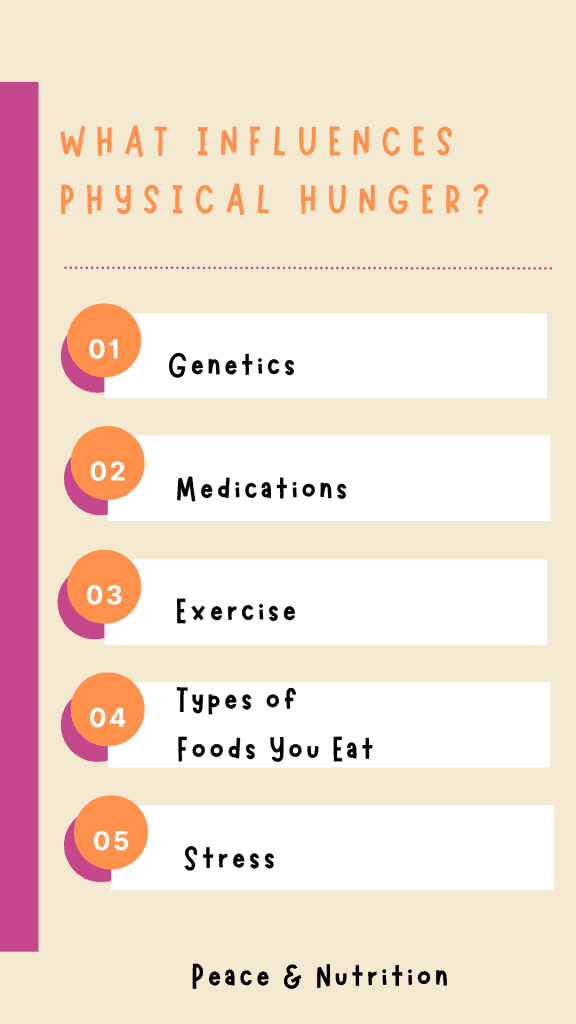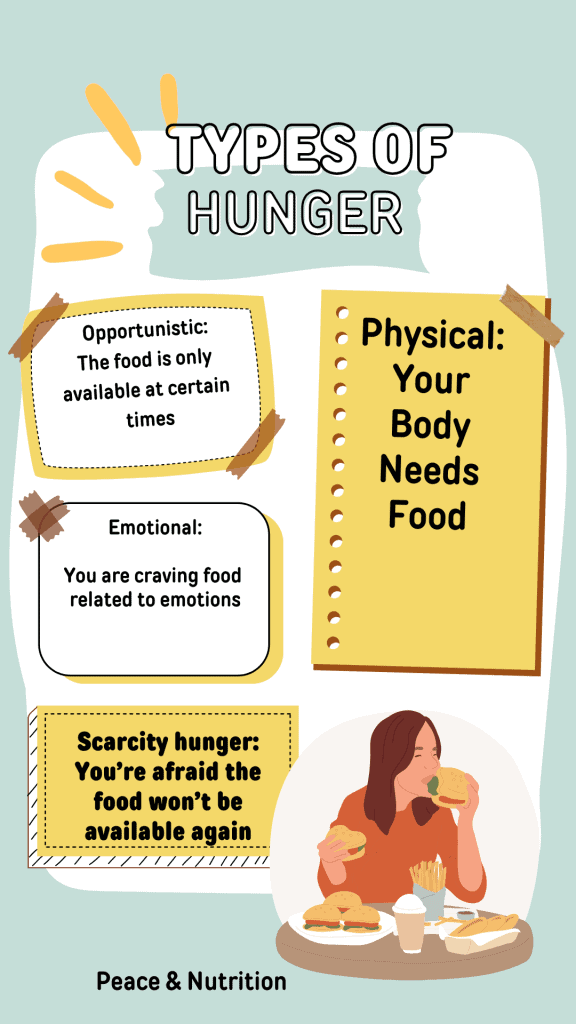Table of Contents
Last updated on June 28th, 2025 at 03:28 am
So you’re hungry. Or… Are you? Did you know that there is more than one type of hunger? Or that all types of hunger stimulate a real biological reaction that increases the demand for food in your body?
The types of hunger are:
- Physical
- Emotional
- Opportunistic
- Taste
- Scarcity
- Competitive
- Anticipating rescriction
No matter which type of hunger you’re experiencing, you’re not doing hunger “right” or “wrong.”
In fact, enjoying food when you’re experiencing all types of hunger is important for your emotional and physical wellbeing, and to prevent the potential for binge eating.
Lets explore the many different types of hunger and where each one comes from. In this article we’ll dig into some of the biological reasons you might feel hungry as well as some of the emotional contributors
Physical Vs. Emotional Hunger
Physical hunger includes the sensations that occur in your body to signal it is time to eat. Physical hunger often includes a growling tummy or an empty feeling in the gut. Physical hunger usually comes on slowly and grows.
Emotional hunger involves the psychological experiences associated with having food available such as excitement, comfort, safety and relaxation. Emotional hunger usually follows intense emotions immediately and food cravings are often intense and specific.
Emotional hunger offers health benefits that physical hunger can’t and vice versa. However, emotional and physical hunger are really just two sides of the same coin. 90% of the messages from the brain are relayed to the gut and vise versa, so it’s almost impossible to experience one without the other.
Hunger is not black or white, good or bad. It just is.
What Causes Hunger
Some of the common signals the body puts out to tell us to eat include increasing:
- Grehlin– which is triggered by insulin being released in the body.
- Neuropeptide-Y-causes us to seek carbohydrate-rich foods in response to hunger
- Salivary Amylase– starts digestion in the mouth and is produced in the presence of food. Salivary amylase can also be produced in response to smells or familiar spaces associated with food.
- Stress can increase cortisol which can increase grehlin
These signals occur with every type of hunger, and thus illustrating how emotional hunger very quickly becomes physical hunger.
7 Different Types of Hunger
Knowing what type of hunger you’re experiencing to help you make decisions about food and feel confident about what you’re eating. This can include decisions about when you want to start and stop eating, but also how you prepare and plan your food.
Identifying why you are feeling a certain way about food can help you to reduce any food guilt associated with eating, avoid mental restriction and truly enjoy food. Not honoring all types of hunger is likely to lead to still feeling hungry even after you finish eating.

1. Physical Hunger:
While physical hunger is often the most obvious type of hunger for us (because it’s literally what keeps us alive) even physical hunger presents in your body in levels. Check out the hunger fullness scale to learn more about your body’s unique physical hunger cues.
Common physical signs of hunger include:
- Growling stomach
- Fatigue
- Lightheadedness
- Dizziness
- Thoughts of food
- Fantasies of food that sounds good
- Salivation surrounding pictures and thoughts of food
- Difficulty making decisions
- Boredom
- Difficulty concentrating
- Anxiety
- Restlessness
2. Emotional Hunger
Emotional hunger is often connected to strong emotions. Eating foods you enjoy or even thinking about eating foods you enjoy can send a rush of dopamine in times of intense emotions.
Examples of emotional hunger include:
- Enjoying your favorite ice cream because you got a promotion at work
- Eating cake because you are sad about a break up
- Enjoying chips and dip because you’re excited about your new video game
- Head hunger if you have undergone a procedure like bariatric surgery

3. Opportunistic hunger
Sometimes hunger shows up just because we know we won’t have the opportunity to eat at a later time.
Some examples of this are:
- The movie you plan to attend starts at 7. 6 p.m. is our only time to eat for the evening. You’re not usually hungry at this time but it makes sense to have a meal when it’s available.
- You have lunch before your lab at 10 a.m. even though you usually don’t eat until noon. You know you’ll get hungry during the lab.
4. Taste hunger
Taste hunger involves the experiences and traditions you have around food. You may begin to develop hunger cues just because of how or when you are used to eating certain foods.
Here are some examples of this:
- A craving for foods only available on holidays
- New foods are available on vacation
- Our grandmother’s cookie recipe always has us salivating no matter how physically full they were before they came in the door

5. Food Competition
Food competition happens when you’re afraid won’t be available of if you don’t seek it out as quickly as possible. This can be common when there’s only a finite amount of a certain item and you want to make sure both your physical and emotional needs for food are met.
Some examples of this are:
- You know you have to get your favorite treats at thanksgiving before they’re gobbled up
- There are only three ice cream bars in the fridge and 4 siblings in the house
- There are 5 people and one pizza. You’re afraid there won’t be enough for you to be satisfied and there’s no other food available.
6. Scarcity hunger
Scarcity hunger can come from not having food regularly available now or in the past. While scarcity hunger might seem primarily emotional, if you have had bouts of food insecurity your body does not forget these moments and amps up your hunger signals when foods, especially foods that were once scarce are present.
Examples of scarcity hunger include:
- You often went hungry at lunch because you couldn’t afford the food at school
- Sometimes dinner wasn’t available growing up
- You were once homeless and keeping food on hand wasn’t possible
- You experienced an eating disorder
7. Anticipation of restriction hunger:
Anticipation of restriction hunger happens for many chronic dietors. This type of hunger comes when you anticipate that food won’t be available in the future.
Some examples of this type of hunger include:
- You tell yourself you’re about to go on a diet
- You have access to foods you normally don’t keep in the house because of restriction
- Your intermittent fasting and anticipating a time of food restriction soon
- You’re afraid to stop counting calories for any foods you eat

Emotional Coping Without Emotional Eating
While emotional eating should always be honored, eating should never be the only way you cope with emotions. This can be a slippery slope but if you notice your always going to food when a big emotion comes there could be some other things you could try.
Some other things you might try to help with emotional regulation include:
- hula hooping
- gardening
- playing games
- medication
- crossword puzzles
- taking a bath
- journaling
It’s very important to remember that activities outside of eating food or restricting food to manage emotions will likely not be as intense at first as eating in response to emotion. This may lead you to believe initially that the ONLY way you can regulate our emotions is through food.
Continue to practice these stress-reducing activities, as their effectiveness in coping will get bigger over time.
- Diet Culture is Toxic - December 22, 2025
- I Don’t Eat Anything White - December 11, 2025
- I Wish I Had More Control With Food - November 18, 2025